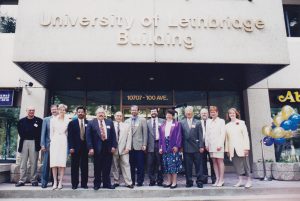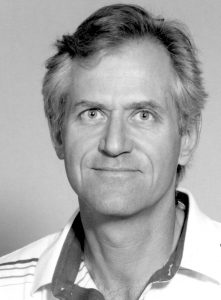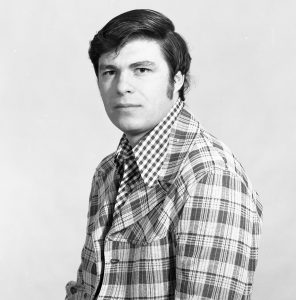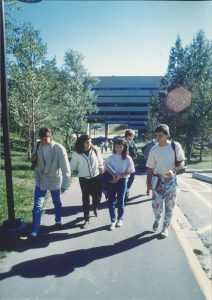In the late 1980s, post-secondary institutions across Alberta were feeling the effects of the recession and budget cuts. The University of Lethbridge was no exception. It was widely known in the university sector that the U of L was broke, student enrolment was going down and there were discussions about closing the University.
When I became president of the U of L on June 1, 1987, the institution was experiencing challenging times. My area of interest is corporate and institutional turnarounds, and there were a number of things that had to be done.
One was to make sure that we didn’t lose the academic expertise that we had in the faculty.
We revamped senior administration and built a new team. We developed a core of strength with VPs serving as chief officers. We recruited Dr. William Sibley (LLD ’00) from Stanford University back to Canada to become our new vice-president (academic). Dr. Ian Newbould followed Sibley, and a few years later, Dr. Séamus O’Shea (LLD ’13) took over the VP Academic office.

University representatives and members of the Faculty of Management celebrated the opening of the University of Lethbridge Building in downtown Edmonton.
Our financial administration team, with people like Nancy Walker (BMgt ’82) and Karen Clearwater (BASc (BA) ’80), was first rate. They were key to our financial recovery. They devised a new budget system where deans received the tuition generated by their Faculties and, for the first time in a Canadian university, kept the funds they did not spend. By providing academic units with carry-forward, they could plan and save for initiatives they wanted to invest in. Government funds were then allocated to other sectors of the University.
We had a very good Board. They worked hard and represented a cross section of business people. We changed the structure of the Board of Governors with the addition of three students and two faculty members. This gave a route and a vent for problems.
In terms of student recruitment, we had to recognize we weren’t just a Lethbridge and district university — our market was Alberta. We started targeting one-third of our enrolment out of Calgary and 10 per cent out of Edmonton, recognizing that only one in four of our target enrolment would come from Lethbridge and area.
A new notion of coopetition was implemented. The U of A and the U of C were not to be poached from. At the U of L, we did things differently. We recruited parents directly in Calgary and rural Alberta. The Chancellor, Dr. Keith Robin (LLD ’92), and I travelled to meet with prospective parents and their students; parents wanted a smaller city — and once their kids started at the U of L, they stayed.
We also changed the image of the institution from an undergraduate teaching university to a full-fledged research university with a defined mission. I began meeting with the Government of Alberta and the Government of Canada’s research agencies, which helped generate a flow of research dollars and we started to find success. One of the things that I’m happiest with is that people now refer to the three research universities in Alberta — the universities of Alberta, Calgary and Lethbridge.
With a very good Master of Education program already in existence, we implemented a new model of graduate programs for other areas, introduced the MA and MSc programs, and established a PhD program.
The Canadian Centre for Behavioral Neuroscience (CCBN) was at the U of L in many ways for many years, even before I arrived. The Kolb-Whishaw team was doing work that was at the Canadian standard and had a shot at being at the North American level. We had to focus our research so they could shine. Part of that was saying we couldn’t do everything — they would be our first priority to develop, just as other priorities have come down the line. Our goal wasn’t to be the best in Alberta or even Canada. We wanted to be known in North America.

Dr. Bryan Kolb (DSc 115)
The Calgary and Edmonton campuses began with the notion of the post-diploma program — which the U of L pioneered in Western Canada — and saying that students who complete year one and two at colleges are very qualified to transfer to the University in their third year and complete the Bachelor of Management program. Once the transfer agreements were made with the initial 23 institutions, we started to see a significant amount of our enrolment transfer in from other institutions.

Dr. Ian Winshaw (DSc’ 08)
The Faculty of Management asked why should students come to Lethbridge if they are working full time in Calgary or Edmonton. The logical thing to do was to offer the management program in these cities. In 1996, we opened campuses in both Calgary and Edmonton. The value these campuses bring is to the student. They provide another type of quality undergraduate education to people who would otherwise not have access to it.

Student enrolment soared at the U of L in the 1990s.
From 1990 to 1999, enrolment nearly doubled, growing from 3,953 students to 6,009. Campus changed considerably over that time. In the fall of 1990, we opened four new residence buildings — Aperture Park — which were built on time and on budget. That same year, we also opened Turcotte Hall and the Students’ Union. In 1995, modular classrooms were installed north of the Physical Education building to help alleviate classrooms shortages, and in 1999, we opened Hepler Hall and a classroom addition to the PE building, and we broke ground for the Library Information Network Centre (LINC).
Our library led the way in applying digital technology with a traditional library, and it was designed for the future. Going to a small university doesn’t mean you do without. In fact, it means that as a student you get more access to more equipment than you would as an undergraduate going to a large institution.
A key thing for a university in its teaching, research, scholarship and performance is that it be an innovator. And I believe the U of L is an innovator. We are continuously innovating: our research, scholarship and performance are in balance.
I enjoyed the whole process of being president. We were supported by the community and the government. In the 13 years that I was president, we had three substantial budget cuts, and on each occasion we grew, expanded and were better at the end of the period. We established financial stability, retained good faculty and built enrolment.
When Bill Cade became president in 2000, we had a smooth transition. He changed things as the marketplace and academic world demanded, but it’s about as good a transition as anyone could have imagined. The University continued to prosper.
We are an Alberta institution all Albertans can be proud of.
Story By Dr. Howard E. Tennant, President Emeritus.

